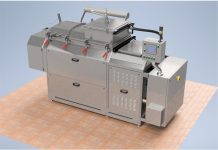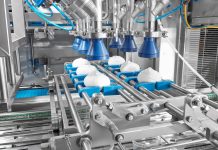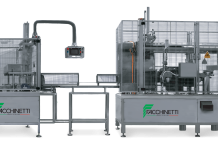 Salt is a key ingredient for the cheese processing. It makes the expulsion of the whey easier, controls microbial growth, influences the product flavour, aroma, rheology, and texture. Salt causes moisture to be expelled through an osmotic effect and through a modification of proteins. The osmotic pressure can be likened to the creation of suction on the surface of the curd, it causes moisture drawning out. The exchange of calcium for sodium in para caseinate has a favourable influence on the cheese consistency. Salt directly affects enzymatic activities and biochemical changes, such as glycolysis, proteolysis, lipolysis and para-casein hydration that occur during ripening. It cuts down spoilage and prevents the growth of pathogens. A precise control of salt uptake and distribution in cheese is a vital part of the cheese making process to ensure consistent, optimum quality. Many factors influence the salt uptake in direct-salted cheese: salting rate, curd temperature, curd moisture content, curd dimensions at salting, curd depth during holding, pH of curd at salting, degree of mixing salt and curd, time elapsed between salting and pressing and salting technology.
Salt is a key ingredient for the cheese processing. It makes the expulsion of the whey easier, controls microbial growth, influences the product flavour, aroma, rheology, and texture. Salt causes moisture to be expelled through an osmotic effect and through a modification of proteins. The osmotic pressure can be likened to the creation of suction on the surface of the curd, it causes moisture drawning out. The exchange of calcium for sodium in para caseinate has a favourable influence on the cheese consistency. Salt directly affects enzymatic activities and biochemical changes, such as glycolysis, proteolysis, lipolysis and para-casein hydration that occur during ripening. It cuts down spoilage and prevents the growth of pathogens. A precise control of salt uptake and distribution in cheese is a vital part of the cheese making process to ensure consistent, optimum quality. Many factors influence the salt uptake in direct-salted cheese: salting rate, curd temperature, curd moisture content, curd dimensions at salting, curd depth during holding, pH of curd at salting, degree of mixing salt and curd, time elapsed between salting and pressing and salting technology.
There are two main technologies for salting cheese after the curd formation and the following syneresis. In the dry salting, the salt is scattered after the cheese is pressed and the moisture degree has been lowered as much as possible by dry air blows or by dwelling in heated room. Hard cheese are pressed. When dry salt is added to milled or rubbed on the surface of a block of curd, moisture is extracted from the surface of the cheese to dissolve the salt crystals. The quantity is spread as evenly as possible over the curd that have to be then stirred for a few minutes. The salt at the surface enters slowly into the cheese. In contact with the concentrated brine at the surface of the cheese, casein contracts expelling whey and generating a definite rind. This free whey dissolves salt crystals and generates a brine solution that spreads on the surface of the curd. Dry salting can be performed either manually or mechanically. There are various ways to distribute salt over the curd mechanically. Equipments can be fed manually or they can be included in an automatic line. After removing any moisture in excess, the curd is cut, the resulting chips are then treated with salt booms. Salt is evenly blown on both faces and edge of the cheese. The salt boom can be controlled by an ultrasonic level transmitter that measures the curd depth and controls the amount of dry salt distributed onto the curd chips. Washed-rind cheeses are treated at regular intervals during their maturation, to prevent the formation of mould and maintaining the rind soft.
Brine salting is used to treat a large varieties of cheese. Brine salting systems of various types are available, from quite simple ones to technically very advanced ones. Still, the most commonly used system is to place the cheese in brine vats. When shaped cheese is plunged in saturated salt brine, a number of critical changes take place in the product during the brining process. Salt is being absorbed into the cheese while whey is being expelled from it. This expulsion of whey is critical for proper moisture control in the final product.
Brine can be kept in different type of containers or bath
Still we find basins made of bricks. The basins are at human height to make it comfortable for workers to put in or is to turn cheese. Inside and out they are covered with tiles, to ease the cleaning operations. Fibreglass vats are also used as salting containers for cheese, but more advanced systems can be of stainless steel, although salt brine in contact with steel can give corrosion problems, depending on pH, salt concentration and temperature. The brining may be done in various ways: in a rack system, in a ‘river ’-type system or in a mixed system. As cheese is less dense than brine and tend to float, to ensure uniform salt concentration throughout, it should be kept under brine level. Single moulds can be immersed on the loose or in rank and cages, with rack the moulds will stay on the shelves and do not float away. A variety of systems for racks are available for large-scale production. A rack is composed of a number of stainless steel shelves, the shelves have perforations therein for the free flow of brine through the shelves and about blocks of cheese. The rank is transported automatically or manually by a top-mounted crane system to the basins. A cluster of pressure valves will secure the same pressure regardless of the number of stacks and ensure that moulds do not emerge from brine. At the end of the desired salting time the ranks are taken to an unloading station and transported to the packing line. This system is space saving and transportable, plus secures a uniform salting of many cheese types, it can be an exception for the very soft cheese that in the trays can be deformed. Other solution is based on continuous flow of brining solution that surrounds blocks of cheese placed in trays. The trays can be made of ABS (plastic of high mechanical resistance). The trays are piled into static stacks, the brine flow enters each consecutive tray, starting from the top, throughout cheese containing trays to the flat bottom drainage station. In river – type automatic system, moulds are convoyed to brine and plunged. The flow degree is correlated to the dwelling time of the cheese in the brine, as the newer mould pushes the older toward the end of the container. After the resting time in brine, the cheese is automatically extracted from the salting basins by a discharge belt conveyor. The use of a inclined and porous belt allows the continuous separation of product from brine with minimal disruption of the brine flow.
Preserve the brine and the cheese
The salt absorbed by the cheese significantly affects its texture, physical and flavour characteristics. Therefore, it is essential to have a good control over the brine and brining operations to be sure to obtain always consistent product .The system need a filtering equipment to remove curd particles and free fat. Salt must be periodically added back to maintain the desired salometer level, as salt concentration is constantly decreasing, and the brine is diluted by the whey coming from the cheese for this it’s always better not to overcrowd the vats with cheese moulds. In certain conditions, especially at the beginning, greasy cheese can result with too high pH values in the salt brine. It is necessary to control the salt percentage and pH in salt brine and possibly adjust with salt and HCl (hydrochloric acid). Brine must be keep in temperature and continuously stirred to prevent density fractionation (lower concentration brine on top) and dilution of the brine around the cheese. The stirring in the basins is made with air blows or by rotating pierced fibreglass or steel trays. Although storage in brine causes a decrease in the populations of undesirable contaminants, poorly maintained brine tanks can become sources of contamination by salt-tolerant pathogens. Monitoring of brines should be regular for yeast counts and the contaminating presence of Listeria organisms, as they can tolerate salt concentrations of up to 20%. As the disposal of salt brine is expensive and often forbidden due to high salt content, brine must be cleaned regularly by pasteurization or by filtration, best if it is micro-filtered. UV sterilization combined with filtration is also used. These procedures decontaminates and restores brine to his original form. The expulsion of whey into the brine dilutes the salt concentration and causes an increase in volume of salt brine solution. To overcome the dilution of brine can be used concentrators that eliminate the excess water in form of vapour.





